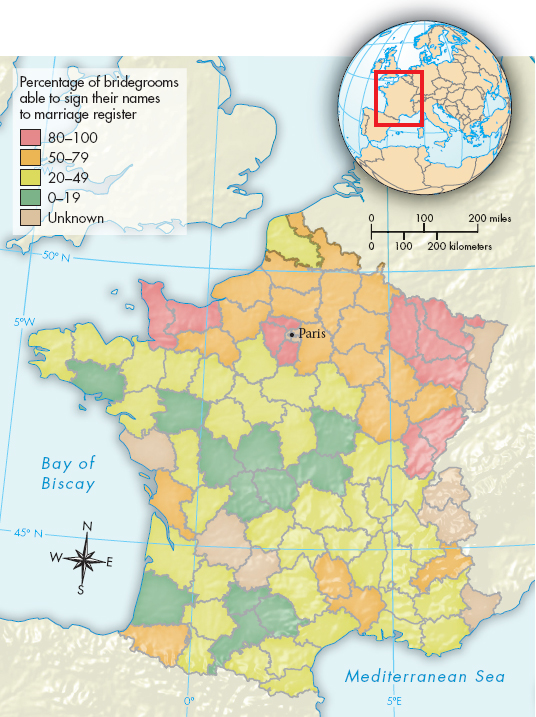Popular Literature
The surge in childhood education in the eighteenth century led to a remarkable growth in literacy between 1600 and 1800. Whereas in 1600 only one male in six was barely literate in France and Scotland, and one in four in England, by 1800 almost nine out of ten Scottish males, two out of three French males (Map 18.1), and more than half of English males were literate. In all three countries, the bulk of the jump occurred in the eighteenth century. Women were also increasingly literate, although they lagged behind men.

CONNECTIONS: Note the highly variable nature of literacy rates across the country. Why might the rate of literacy be higher closer to the capital city of Paris? Why would some areas have low rates?
The growth in literacy promoted growth in reading, and historians have carefully examined what the common people read. While the Bible remained the overwhelming favorite, especially in Protestant countries, short pamphlets known as chapbooks were the staple of popular literature. Printed on the cheapest paper, many chapbooks featured Bible stories, prayers, and the lives of saints and exemplary Christians.
Entertaining, often humorous stories formed a second element of popular literature. Fairy tales, medieval romances, true crime stories, and fantastic adventures were some of the delights that filled the peddler’s pack as he approached a village. Some popular literature was highly practical, dealing with rural crafts, household repairs, useful plants, and similar matters. Much lore was stored in almanacs, where calendars listing secular, religious, and astrological events were mixed with agricultural schedules, arcane facts, and jokes. The almanac was highly appreciated even by many in the comfortable classes. In this way, elites still shared some elements of a common culture with the masses.
While it is safe to say that the vast majority of ordinary people did not read the great works of the Enlightenment, they were not immune from the new ideas. Urban working people were exposed to Enlightenment thought through the rumors and gossip that spread through city streets, workshops, markets, and taverns. They also had access to cheap pamphlets that helped translate Enlightenment critiques into ordinary language. Servants, who usually came from rural areas and traveled home periodically, were well situated to transmit ideas from educated employers to the village.